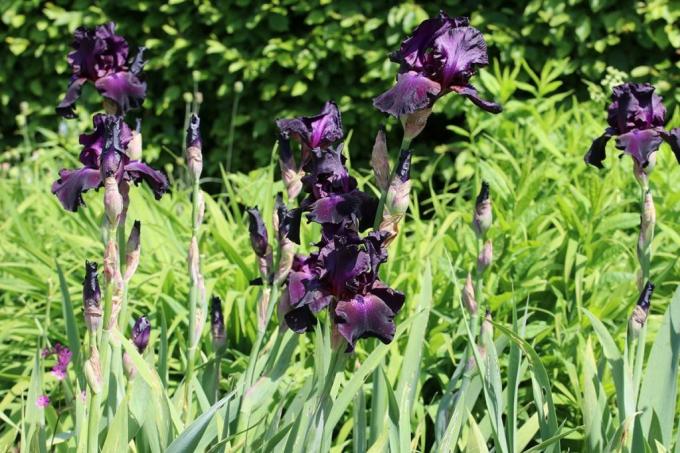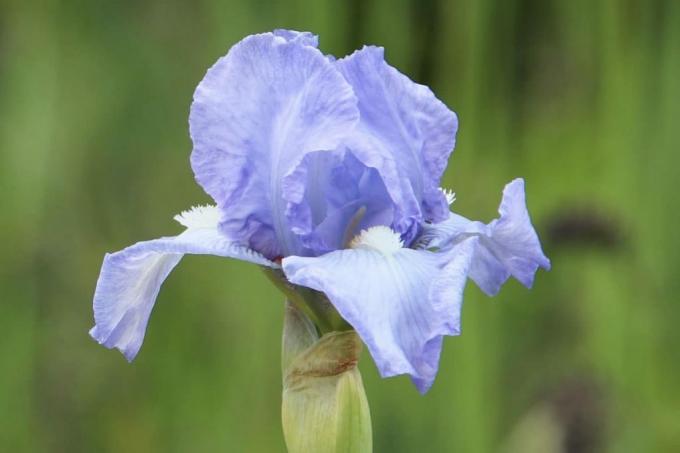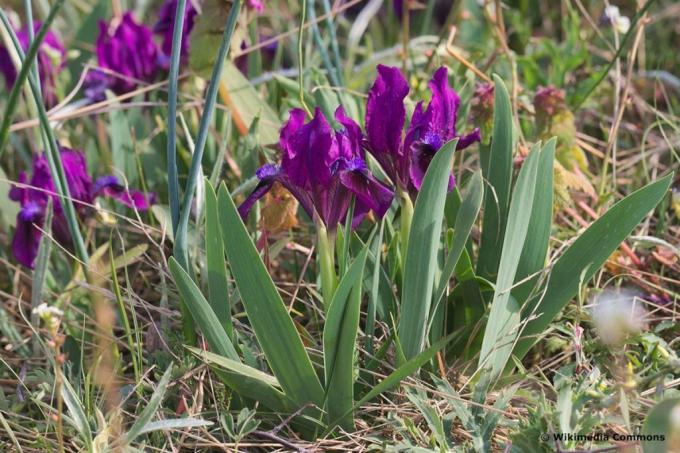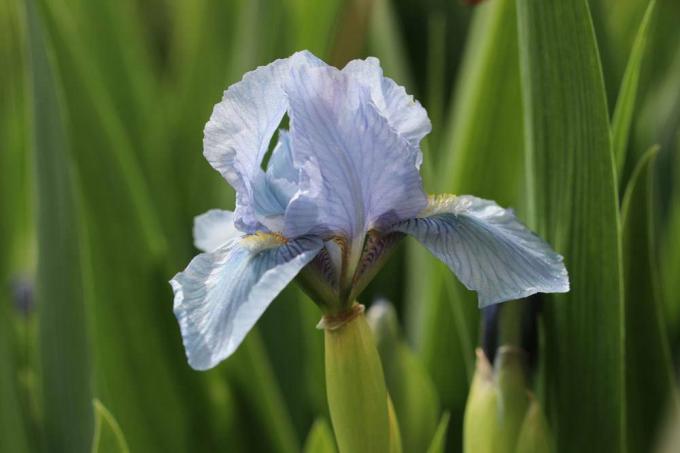
table of contents
- Bearded Iris (Iris × barbata)
- High bearded iris (Iris x barbata elatior)
- Medium-high bearded iris (Iris x barbata media)
- Dwarf Irises (Iris pulima)
- Siberian iris (Iris sibirica)
- More popular types
- frequently asked Questions
Irises, also known as irises, are one of the most popular garden perennials with their uncomplicated nature and beautiful flowers. There is an almost unmanageable number of types and varieties. We present 45 particularly attractive irises to you.
In a nutshell
- species-rich genus of the iris: more than 300 species
- numerous cultivars and cultivars
- exact number of varieties unknown
- diverse flower colors
- Summer bloomer
Bearded Iris (Iris × barbata)
The almost unmanageable cultivated forms of the are particularly popular in the garden Beard iris, which are divided into three different groups depending on the height and flowering time. The Iris x barbata, however, is not a specific species of iris, but rather Hybrid breeds with a common external characteristic: the characteristic "beard" on the Hanging leaves.
High bearded iris (Iris x barbata elatior)
The varieties belonging to the Hohen Bart-Iris grow to a height of at least 70 centimeters and bloom from late May to June.

'Ambassador'
- up to 90 centimeters high
- deep wine-red flowers with partly tabby hanging leaves
- Flower colors can vary
- proven and robust variety
'Boule de Neige'
- up to 80 centimeters high
- Flowers white with a yellow center
- wavy edge of the flower
- needs full sun, dry location
Note: This variety is also considered extremely frost-hardy and is otherwise very robust. In addition, the nectar-rich flowers attract bumblebees and bees.
'Changing Times'
- up to 80 centimeters high
- whitish pink and purple petals with a yellow beard
- proven American breed from 1977
- particularly suitable for group plantings
Tip: Cut faded or dried up stems to extend the flowering time of this beautiful variety.
'Echo de France'
- up to 90 centimeters high
- Two-colored flowers, pure white and yellow
- proven breed from 1984
- very suitable for group plantings
'Foamy Wave'
- up to 90 centimeters high
- intense blue petals with white mirror
- Flowers relatively small
- very suitable for bucket culture
'Golden Trimmings'
- up to 80 centimeters high
- multicolored flowers: standards white and light yellow, pendulum leaves white and orange
- proven breed from 1973
- very hardy
'Gypsy Romance'
- up to 80 centimeters high
- intense purple-purple flowers with a dark purple beard
- Cut off what has faded
- goes well with roses and Mediterranean plants
'Haut les Voiles'
- up to 90 centimeters high
- attractive two-tone, fragrant flowers: creamy white standards, pale blue pendulous leaves
- develops many flower stalks
- proven breed from 2000
Tip: Irises do not tolerate waterlogging at all, which is why the soil should be drained before planting.
'Jurassic Park'
- up to 120 centimeters high
- Contrasting flower color: violet hanging leaves, light yellow standards
- light fragrance
- striking breed from 1995
'La Vie en Rose'
- up to 90 centimeters high
- uniform pale pink petals with an orange beard
- subtle floral scent
- goes well with other perennials with dark flower colors
Tip: After flowering, you should keep the stems down to approx. Cut off ten centimeters above the rhizome.
'Mulled Wine'
- up to 100 centimeters high
- Flowers in dark raspberry red and deep orange
- popular American breed from 1982
- floriferous and hardy
'Musician'
- up to 80 centimeters high
- tricolor breed from 2004
- Apricot-colored standards, hanging leaves white with purple-red veins, orange-colored beard
- well suited for group plantings and perennial beds
'Natchez Trace'
- up to 80 centimeters high
- maroon and apricot colored flowers
- light fragrance
- tolerates drought and needs a lot of sun
'Night Owl'
- up to 90 centimeters high
- especially dark, blue flowers
- Flowers appear particularly large and velvety
- Breeding from 1970
'October Sun'

- up to 80 centimeters high
- sun-yellow, slightly fragrant flowers
- well branched flower stalks
- Well suited for both individual and group planting
'Oregon Skies'
- up to 90 centimeters high
- uniformly light blue flowers with a yellow beard
- particularly strong foliage
- goes well with lavender or ornamental onions
'Owyhee Desert'
- up to 80 centimeters high
- attractive three-colored flowers: white standards, pendulum leaves with a white base color and brownish-purple markings
- pleasantly fragrant
- also very suitable for pail culture
'Parisien'
- up to 90 centimeters high
- white-purple flowers with an orange beard
- long flowering period
- well hardy
'Raptor Red'
- up to 90 centimeters high
- velvety, deep brown-purple flowers
- very young breed from 2008
- strong growth, free flowering
Tip: This variety is particularly effective between evergreen ground cover or in combination with roses.
'Schiaparelli'
- up to 80 centimeters high
- bright pink, striking flower color
- popular American breed from 1972
- particularly suitable for perennial beds
'Stepping Out'
- up to 80 centimeters high
- two-colored flowers: white with a purple border
- distinctive and eye-catching breed from 1964
- easily divisible variety
Note: If the rhizomes of an iris are mushy and / or smell unpleasant, this is mostly due to the unsuitable location. Dig up the plant and put it back in a full sun and dry place.
'Superstition'
- up to 90 centimeters high
- Rare flower color: deep black-violet pendulous leaves, violet standards
- intense floral scent
- branched growth
'Wine and Roses'
- up to 80 centimeters high
- two-colored flowers: pink standards, purple hanging leaves, orange beard
- Very popular breed from 1963 to this day
- well hardy
Tip: You should divide this variety every three to four years as older specimens lose their flowering pleasure. The division rejuvenates the plants.
The medium-high varieties of bearded iris bloom from May to June and reach heights of between 40 and 70 centimeters.

'Arctic Fancy'
- up to 50 centimeters high
- two-colored, very contrasting flowers: white with a dark blue border
- fragrant and free-flowering variety
Tip: When planting, place the rhizomes only two-thirds in the ground, so that one-third is sticking out of the soil. This prevents laziness.
'Eleanor Roosevelt'
- up to 60 centimeters high
- Flowers dark blue with a purple sheen
- floriferous
'Florentina'
- up to 60 centimeters high
- fragrant, white flowers
- floriferous
,Dawn'
- up to 50 centimeters high
- free flowering variety with bright light blue flowers
'Scintella'
- up to 60 centimeters high
- fragrant, pale yellow flowers
- floriferous with good branching
Dwarf Irises (Iris pulima)
The dwarf irises, which remain small, are only between 15 and 30 centimeters high and are very early bloomers: they show their blooming splendor as early as the end of April.

'Alsterquelle'
- colorful, variable flower color: light blue to light purple, yellow to white
- up to 25 centimeters high
'Cherry Garden'
- up to 30 centimeters high
- wine-red, fragrant flowers
'Gleaming Gold'
- up to 30 centimeters high
- free flowering variety with yellow flowers
'Lilly White'
- up to 20 centimeters high
- pure white flowers
- well branched inflorescences
'Little Sapphire'
- up to 30 centimeters high
- light blue flowers with darkly veined pendulous leaves
'Little Shadow'
- up to 30 centimeters high
- dark violet-blue flowers, pendulum leaves darker
Note: Dwarf irises are not only suitable for borders, but are also great for planting in window boxes and small pots.
'Wrestler'
- two-colored flowers: brownish red with a yellow mirror
- up to 30 centimeters high
'Snugglebug'
- Wine-red to brownish flowers with a purple beard
- up to 25 centimeters high
Siberian iris (Iris sibirica)
The Siberian iris is perfect for planting the banks of garden ponds, but can also be used for borders and beds. The soil should be fresh and humus. The species, also known as the beardless iris, is a summer bloomer and shows its splendor between May and June.

'Butter & Sugar'
- up to 60 centimeters high
- Flowers yellow with a white throat
'Caesar's Brother'
- up to a meter high
- midnight blue flowers with patterned hanging leaves
'Perry's Blue'
- up to 80 centimeters high
- very many small, blue flowers
'Snow Queen'
- up to 80 centimeters high
- pure white flowers
'Sparkling Rose'
- up to 80 centimeters high
- dark, reddish-purple flowers with white markings
- Flowers resemble orchids
More popular types
Asiatic sword lily (Iris laevigata)

- up to 80 centimeters high
- violet-blue, variable flower color
- for fresh to damp floors
Native marsh sword lily (Iris pseudacorus)

- native species with bright yellow flowers
- ideal for bank planting and damp soils
- up to 80 centimeters high
- blooms between June and July
Swamp sword lily (Iris versicolor)

- ideal for shallow water or damp / swampy garden soil
- up to 80 centimeters high
- purple, clearly veined flowers
- Flowering period between June and July
frequently asked Questions
As of 2020, there are over 300 different wild-growing iris species worldwide. In addition, there are the hybrid forms of culture such as the popular bearded iris, which, strictly speaking, is not a botanical species. Not even experts know exactly how many cultivars there are.
The lily species that prefer dry soils and a sunny location can be combined very well with roses, lavender, peonies, delphiniums, daylilies, tulips and poppies. Grasses such as giant feather grass (Celtica gigantea) or blue fescue (Festuca cinerea) also harmonize well.
No, irises do not form bulbs like tulips or daffodils, but survive in rhizomes. The only exception is the fishnet iris. Every autumn the above-ground parts of the plant die off and the tuber or the rhizome remains in the ground. The iris will sprout again next spring.


